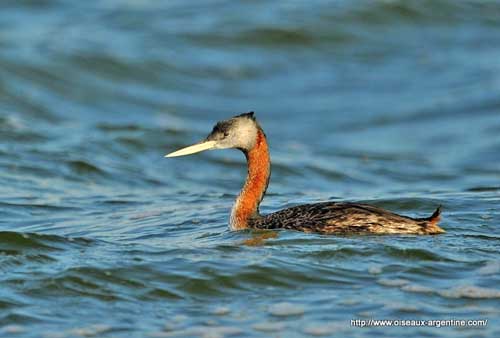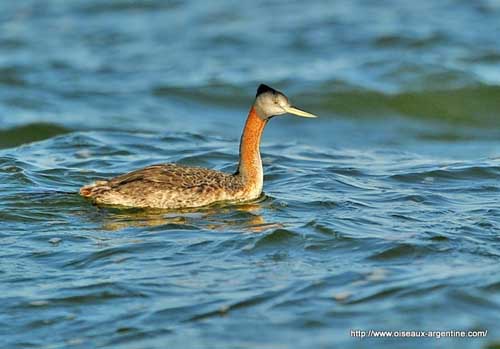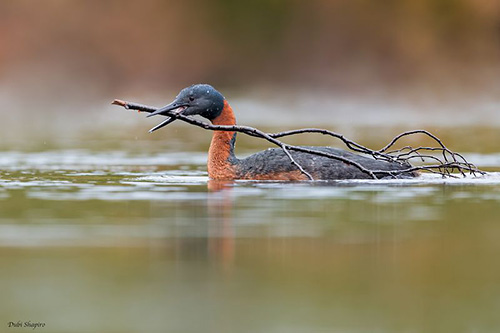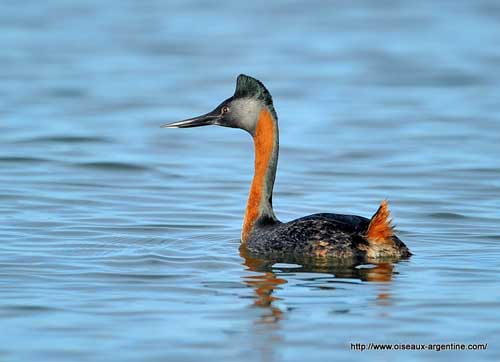
Great Grebe
Podiceps major
Podicipediforme Order – Podicipedidae Family
BIOMETRICS:
Length: 67-77 cm
Weight: 1600 g
DESCRIPTION :
The Great Grebe is a very large grebe, the largest of this family. This South American species frequents the open waters.
The adult has dark grey upperparts, including hindneck, wings and tail. On the upperwing, primary and secondary flight feathers are whitish.
The underparts are white, except foreneck, breast sides and undertail feathers which are rufous. The underwing is white.
The head is dark greenish-grey with short, darker crest on the crown.
In non-breeding plumage, the face is whiter with greyish crown and neck.
The bill is long, dagger-like, greyish with paler tip. The eyes are deep red to dark brown. The feet are characteristic of Podicipedidae, with each toe equipped with loose fleshy membrane allowing the bird to swim easily. The legs are short. Legs and feet are blackish.
Both adults are similar, but the female is slightly smaller than the male.
Fr: Grand Grèbe
All : Magellantaucher
Esp : Somormujo Macachón
Ital : Svasso maggiore del Sudamerica
Nd: Grote Fuut
Sd: Stordopping
Port: Mergulhão-grande
Photographers:
Eduardo Andrés Jordan
MIS AVES – AVES DE ARGENTINA
Dubi Shapiro
Dubi Shapiro Photo Galleries
Philippe et Aline Wolfer
GALERIE
Text by Nicole Bouglouan
Sources:
HANDBOOK OF THE BIRDS OF THE WORLD vol 1 by Josep del Hoyo-Andrew Elliot-Jordi Sargatal - Lynx Edicions - ISBN: 8487334105
BirdLife International (BirdLife International)
SORA Searchable Ornithological Research Archive (Blair O. Wolf)
The Cornell Lab of Ornithology – Neotropical birds

The immature is paler, with pale grey head and upperparts, and white underparts. The neck sides are slightly washed rufous. The bill is pale grey.
The chick has black and white striped down.
There are two subspecies:
P.m. major is found in NW Peru (isolated population), Paraguay and extreme SE Brazil, S to Patagonia and C Chile.
P.m. navasi occurs in S Chile. This race is not universally accepted and can also be named P.m. leucopterus. This race is larger with blacker head.
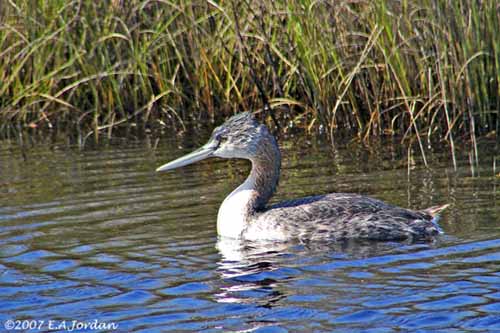
VOICE: SOUNDS BY XENO-CANTO
The Great Grebe utters varied calls but it is generally silent outside the breeding season. It utters whistling and wailing calls, but also barking sounds.
The advertising call is given by a solitary bird, but this call ceases as soon as another grebe is visible.
The alarm call is a repeated high-pitched barking.
The song is a whistle, sometimes a slow mewing call, or a rapid series of “cow, cow, cow…”
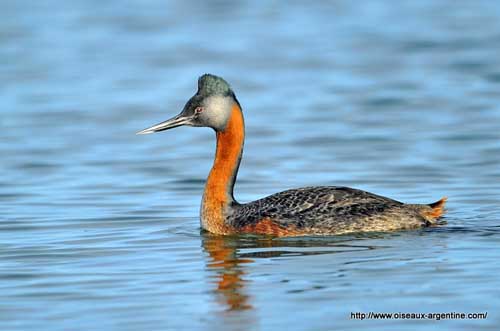
HABITAT:
The Great Grebe is often seen in open waters such as lakes at low elevation, or slow-moving rivers in forested areas, and also inlets with fringing vegetation on large lakes.
But outside the breeding season, this species can be found along the coasts, in estuaries and bays, and even sometimes on open sea.
The non-breeding birds may remain in these areas all year round.
RANGE: See above in “subspecies”
BEHAVIOUR:
The Great Grebe feeds primarily on small fish and also, but in smaller quantities, on crustaceans, molluscs and insects. It takes numerous small crabs in rocky coastal waters.
It feeds by rapid diving in open water, thanks to the specialized feet. The fleshy membrane stretches under the water pressure and propels the bird. When diving, it depresses its feathers before submerging.
The prey is brought to the surface in the bill, and manipulated before to be swallowed head first. The food item is sometimes dropped and lost.
The Great Grebe performs preening and bathing as other grebes. But swimming-shakes are frequent. The bird faces into the wind and raises partially the body out of water. Then, it flaps the wings to remove the water.
Another typical posture is the “one-wing-one-foot stretch” with often the crest raised.
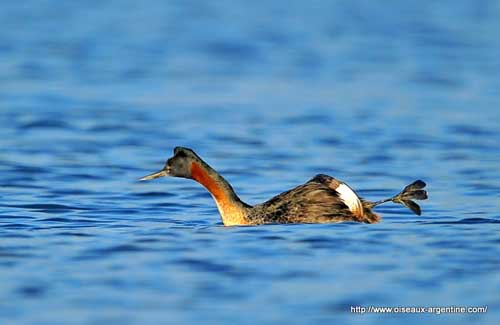
The Great Grebe may be aggressive, adopting a typical posture with the head lowered and the bill parallel to the surface. According to head and body levels, we can know the intensity of the threat. The grebe may also display the white wing patches with the wings raised and partially spread. This is an intense threat posture.
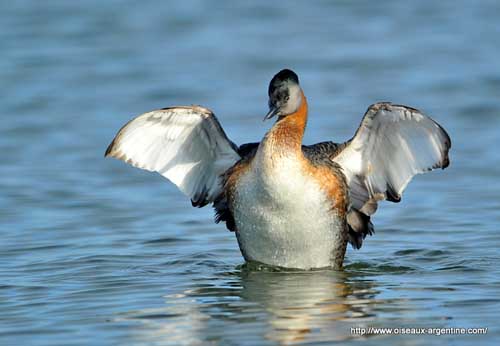
During the confrontations, the birds may fly at each other, ending breast to breast with raised bodies. They pursue the rival by diving or skimming across the water with the feet paddling very fast.
During the breeding season, the Great Grebe performs elaborate courtship displays. Some of them are typical of grebes, but others can be different. This species does not perform the display during which the body is held vertically in the water, and they do not display with vegetation in the bill.
Some postures are observed such as both mates swimming side to side with S-neck appearance, slow head shakes and turning. The crest is usually raised during these displays and the birds often turn face to face while moving their heads.
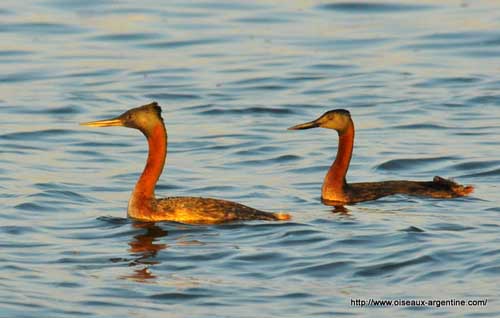
Several displays can be performed between both mates, more or less similar to those of other grebes, but generally less stereotyped.
The copulation occurs out of the water, usually on a platform built by both sexes.
The Great Grebes gather in large flocks of several hundreds birds outside the breeding season, and often occur in coastal waters during this period. Later, at the onset of the breeding season, they move to freshwater lakes and rivers.
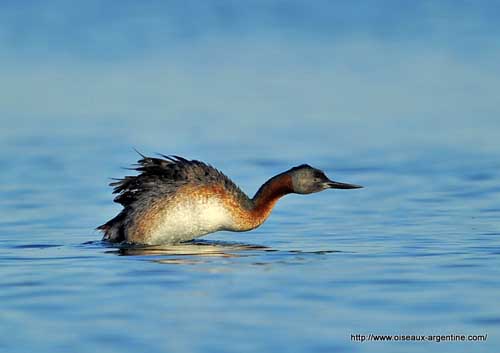
FLIGHT:
The Great Grebe needs to run over water in order to take off, while performing rapid wingbeats. During the flight, the wingbeats are fast.
This bird can fly quickly and over relatively long distances with the neck stretched forwards, and the feet trailing behind.
REPRODUCTION:
The breeding season appears irregular, with some populations breeding at any season of the year. The laying occurs between October and January, and later in the southern parts of the range. The Peruvian population may breed twice a year in September-October and January-February.
The Great Grebe may form breeding colonies. The nest, usually built by both sexes, is a floating platform made with aquatic vegetation, leaves and stems. It is anchored to a clump of aquatic plants or built up from the bottom.
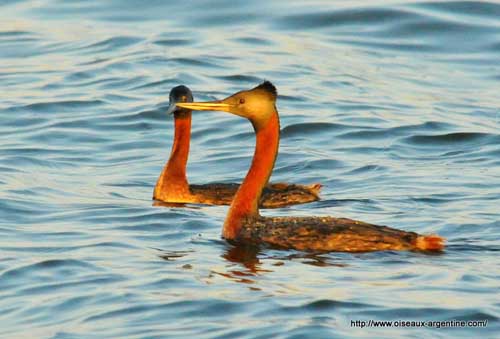
The female lays 3-5 eggs. The incubation is shared by both adults which have brood patches. They incubate during 25-30 days. The pale-coloured eggs become quickly stained brown with the pigments of the vegetation. The adults cover the eggs with plant matter when they leave the nest for feeding.
The chicks are precocial and leave the nest very soon after hatching. They are able to swim and to dive, but the female often carries them on her back during the first days. They depend on parents for food. The fledging period varies from 44 to 75 days, but more information is needed.
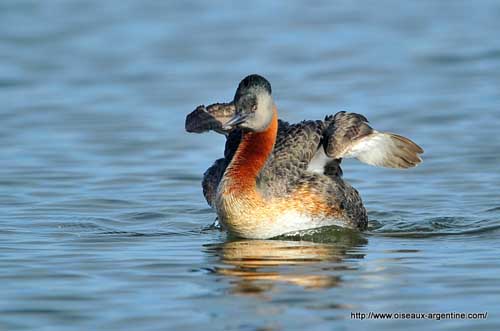
DIET:
The Great Grebe feeds mainly on small fish, but it also consumes aquatic insects, crustaceans and molluscs.
When they frequent the coastal areas outside the breeding season, they feed mostly on small crabs found in the rocky coasts. It forages by rapid diving underwater.
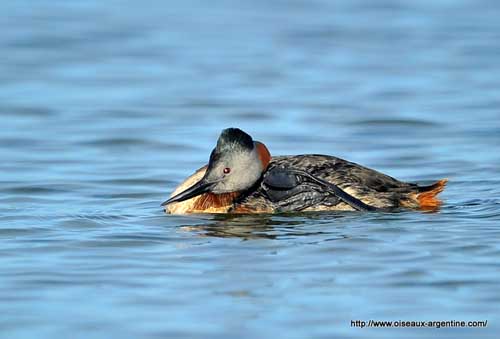
PROTECTION / THREATS / STATUS:
The Great Grebe is widespread and common in its range. The wetland areas where the species is living remain virgin and only slightly altered.
The populations are stable and are not currently threatened.
